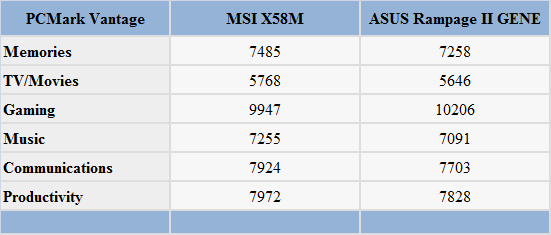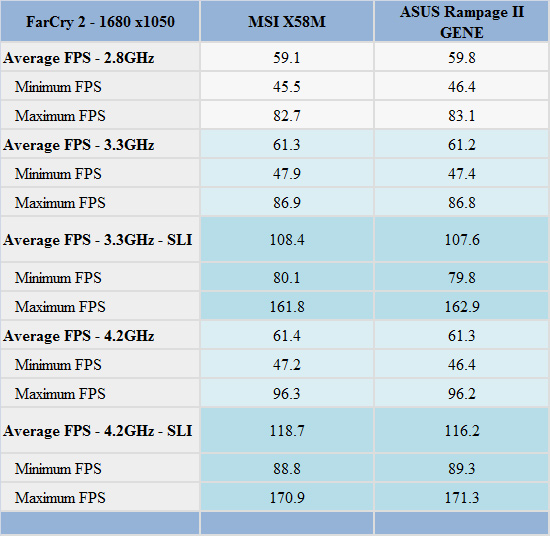General Performance – PCMark Vantage
Futuremark's PCMark Vantage x64 is probably the single most diverse set of benchmarks that can be run on a system to mimic real world usage scenarios. The TV and Movies, Gaming, and Music Suites can be frighteningly difficult to pass when a system is not set up correctly. We've had boards in the labs that will pass hours of Prime95 torture testing or OCCT that fail even the basic 30 minute run of PCMark Vantage, let alone the full 1 hour and 30 minute test run that we loop five times.

These test results surprised us, to the point where we ran the benchmark twenty five times on each board and across each of three different BIOS releases looking for an explanation. Historically, ASUS does very well in the gaming and 3D benchmarks which is evident in the gaming benchmark suite, but performance in the other test suites is different from previous results. We fired up our application benchmarks from the full review test suite and in each case, the MSI X58M had a slight advantage in applications ranging from Sony Vegas Pro 9.0 to Adobe Photoshop CS4. So, advantage to MSI in our general performance benchmarks.
General Performance – Multitasking
We devised a quick multitasking test that allows us to stress test these platforms with real world applications that simultaneously utilize the GPU, CPU, memory, and storage subsystems. We load up Sony Vegas Pro 9.0 64-bit and set it to transcode a 1080p video while running our Far Cry 2 loop benchmark at 1680x1050 2xAA DX10 High Quality in window mode. Average CPU usage is 98% throughout this process with HT enabled. We also capture the total system power draw at the wall less the monitor and keep track of Core 1 temperatures via Everest 5.01. We tested at 21x160 (3.3GHz) since this setting is basically a free overclock with our setups as voltages do not need to be increased - in fact, we actually lowered core vid slightly from the auto setting of 1.080V.

The MSI X58M’s performance numbers were just ahead of the ASUS board in both the frame rate measurement and the time it took to complete the 1080p transcode. Both boards were extremely stable and neither one failed during 25 iterations of this benchmark. Ambient temperatures were at 21C during testing.
The MSI board holds a slight advantage in idle wattage since the Core i7 920 is idling at 0.840V compared to 1.006V for the ASUS board due to differences in the BIOS setup. At full load the 920 is drawing 1.008V on the MSI board and around 0.972V on the ASUS board, once again due to BIOS differences in how Core Vid is applied with power management features enabled. This results in a slightly lower system draw for the MSI at idle and higher than the ASUS at full load with temperatures following the same pattern.
If we enable ASUS’s iTracker software on their GTX 260 Matrix card and set the profile to power savings, our system idle numbers dropped to 159W and load ranges to 310W on both boards. These are excellent numbers for a top tier performance setup considering our case and component choices.
Gaming Performance – Far Cry 2
This title has beautiful graphics, an open ended environment, and is fun to play. If you dial up the graphics options, the game rewards with you some fantastic visuals courtesy of the Dunia Engine. The game also features the most impressive benchmark tool we have seen in a PC game. We set the performance feature set to Very High, graphics to High, and enable DX10 with AA set to 2x. The in-game benchmark tool is utilized with the Ranch Small level and we report an average of three test runs.


We have always applauded ASUS for their strong graphics results in a variety of tests and our PCMark Vantage test revealed their particular strength in the gaming test. We see the ASUS board continuing this pattern in the stock core speed with single card results. Interestingly enough, once we raise the core clock speed or introduce SLI into the equation, the MSI X58M generates better results. The differences are minimal but for the first time in recent memory, we do not see ASUS winning this particular benchmark.










25 Comments
View All Comments
Gary Key - Monday, May 25, 2009 - link
I mentioned on page three about the IOH temperatures, up around 86C or so when overclocking and the board really needs some type of active cooling in that area for 24/7 OC settings. Those temps are still within spec but about 12C higher than the GENE board at like settings. That said, this heatsink worked better than the Platinum board from MSI.GeorgeH - Saturday, May 23, 2009 - link
Wow. With this board and one of Microcenter's $200 i7 920's, you could build yourself what is essentially a top of the line PC for next to nothing right now. It really makes me wonder what to expect from i5 - it's starting to look like it'll have to be either dirt cheap or offer >90% of i7's performance for it to be a truly interesting option.FaaR - Saturday, May 23, 2009 - link
As a happy owner of the ASUS Rampage II Gene, I really must say this looks like a great board. I know many people think the Gene's overpriced, and on some level I agree with them. I just happen to think the price I paid was worth it. ;)To those that don't like the high cost of the Gene, this board would make an excellent substitute. Heck, it's even a smidgen faster in most tests, how's that for value huh? :D Still, on the whole I prefer my Gene. It has the attention to detail where it really counts, IMO, apart from the MSI board having PCIe x4 instead of the Gene's x1 (slots which become blocked anyway as soon as a double-wide GPU is insterted in the nextdoor x16 slot, making the advantage rather moot...)
The Gene has passive cooling on the VRMs as standard, makes me breathe a bit easier with regards to the safety and longevity of the components involved. The Gene also has five WELL-PLACED fan headers (all of them of the 4-pin variety for PWM speed management). It has PCIe x16 slots with convenient little pedals to release the board in the slot, instead of those horrific pull-tabs on the MSI board which always makes me curse whenever I have to blindly dig around inside of a case to get the card out. I also really REALLY like the Gene's software X-Fi sound, the driver works great and sounds great once it's been set up.
And then there's the little power/reset/safe memory/cmos clear buttons too, for those who like stuff like that. Personally I can't really reach any of the mobo buttons once the board's mounted in my case even if the lower PCIe slot isn't housing a 2-slot GPU, but at least they're there for those who can, and they glow in soft-off mode to indicate the board has power so you don't go pulling stuff out without first shutting things off properly...
All in all, the ASUS board is a bit more polished, although at a greater cost. As is usually the case. :)
goinginstyle - Saturday, May 23, 2009 - link
Wow, somebody finally gets the fact that overclocking and Crysis is not what makes an article, although I like your overclocking results. I hope the roundup gives us more tests results like these. I thought this was a full review based on seven pages as you covered just about anything I wanted to know in this preview. Thank you for a preview that is just not pictures and press release text!danger22 - Monday, July 26, 2010 - link
does anyone know if win server 2008 x64 supports this board?